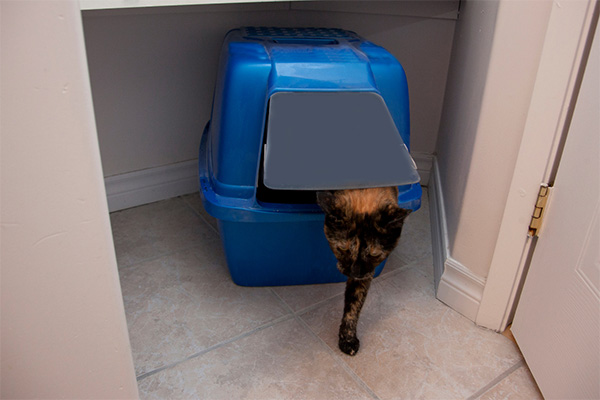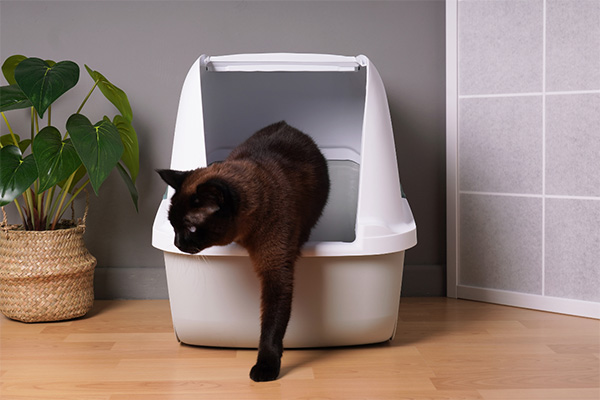When it comes to caring for cats, a crucial aspect often overlooked is the strategic positioning of the litter box. It's not just about finding a corner to tuck it away; it's a thoughtful process that balances your cat's need for privacy with the practicalities of your living space. Whether you're in a sprawling house or a cozy apartment, pinpointing that purr-fect spot is key.
In this post below, we will help cat owners discover the perfect location for litter boxes that work for you and your feline friends, even those with smaller spaces. Nailing the right location means a happy cat and a harmonious home, free from unwanted surprises.
How To Choose A Litter Box Location
Quiet and Private
Selecting a quiet and private location for a cat litter box is essential, as cats naturally seek solitude and tranquility during elimination. A peaceful environment minimizes stress and distractions, encouraging regular litter box use. High-traffic or noisy areas can cause anxiety, leading to avoidance behaviors. Providing a secluded spot respects a cat’s instinctual need for privacy and security, ensuring their comfort and maintaining consistent litter box habits, which is vital for their overall well-being and the home's cleanliness. If this is difficult, try to place a room divider to provide your cat with a private and safe space.

Easily Accessible
Ensuring that a cat litter box is easily accessible is crucial for promoting consistent use and maintaining feline hygiene. Placing it in a location where your cat can reach the litter box easily without obstacles or interruptions minimizes the risk of accidents or avoidance, which is critical, especially in a small apartment. If you live in a small space, paying attention to your cat's behavior is important to avoid any unwanted accidents.
Accessibility is particularly important for kittens, elderly cats, or those with mobility issues. An accessible litter box fosters a comfortable and stress-free environment, encouraging proper elimination habits and contributing to your cat's overall health and happiness.
Separate from Food and Water
Just as humans don't like to eat in the bathroom, cats prefer to keep their eating and litter box areas separate. This separation aligns with a cat's natural preference for cleanliness and reduces the risk of contaminating food and water with litter particles or bacteria. A distinct location for the litter box promotes hygienic habits and ensures that cats feel comfortable both when eating and using the litter box, contributing to their overall well-being and health.
Safe and Secure
It's essential for cats to feel secure while using the litter box. Avoid locations that might make your cat feel trapped, such as tight corners, closed closets, or areas with only one escape route. When cats feel safe, they are more likely to establish and maintain regular litter box habits, reducing stress and potential litter box avoidance issues. Providing a secure environment for your cat's litter box contributes to their overall well-being and peace of mind.
Multiple Boxes in Different Locations
Having multiple litter boxes in various locations can prevent competition and stress in a home with more than one cat. Providing one litter box and an additional one per cat is recommended in a household with multiple cats. This approach ensures that each cat has its designated space, reducing the likelihood of territorial disputes.
Most cats can be possessive about their litter territory, and having multiple boxes distributed throughout the home prevents dominance struggles. This arrangement also reduces the likelihood of overcrowding, ensuring that every feline family member can comfortably use a litter box without stress or competition, ultimately promoting harmony and hygienic habits.
If you have a single cat, you might manage with just one litter box in a small apartment, provided you can clean it frequently.
Consider the Type of Litter Box
Deliberating on the type of litter box you choose is essential to accommodate your cat's preferences and maintain a clean environment. Covered boxes should be placed in well-ventilated areas to prevent odor buildup, as cats can be sensitive to confined spaces. Open litter boxes thrive in discreet yet accessible locations, offering convenience and reducing the risk of odor accumulation. Tailoring the location to the type of litter box ensures a comfortable and hygienic experience for your feline friend, fostering consistent litter box use.
Easy for Cleaning
Opting for a litter box placement that is easy to clean is a practical choice for pet owners. Choosing a convenient location encourages consistent upkeep, guaranteeing that the litter box stays clean and free from odors. When the location is easily accessible for cleaning, it encourages pet owners to scoop waste promptly, preventing odor buildup and maintaining a hygienic environment for both cats and humans. Easy cleaning also contributes to the longevity of the litter box and promotes consistent litter box habits, supporting your cat's well-being and the overall cleanliness of your home.

Lighting
Appropriate lighting near the cat's litter box is vital to ensure their comfort and confidence. Cats tend to favor well-lit areas that enable them to see their surroundings while using the litter box. Adequate lighting also helps pet owners monitor the cleanliness of the box and promptly address any issues. Nevertheless, it's crucial to strike a balance—steer clear of excessively harsh or glaring lights, as they can be unsettling for cats. Providing suitable lighting near the litter box promotes a relaxed and hygienic environment, encouraging regular use and preventing avoidance behaviors.
Common Mistakes to Avoid
Avoid Frequent Changes
Frequent changes in the location of the cat litter box can lead to confusion and stress for your feline companion. Cats thrive on routine, and a consistent litter box location helps them establish a comfortable and familiar elimination spot. Avoiding frequent changes ensures that your cat can confidently access their litter box, promoting regular use and reducing the risk of litter box avoidance. Consistency in location is essential for a harmonious environment and supports your cat's overall well-being.
Avoid Hot And Humid Locations
Don't put the litter box in a hot and humid spot; it is crucial for your cat's comfort and hygiene. Cats prefer a temperate environment when using the box. High temperatures and humidity levels can make the litter clump poorly and create an uncomfortable atmosphere for your feline friend. To ensure that your cat feels at ease while using the litter box, choose a location that maintains a moderate climate, preventing issues with clumping and fostering regular litter box habits.
Avoid locations with Too Much Noise
Choosing a cat litter box location that avoids noisy areas, like the laundry room, is practical. Cats prefer quiet spots for elimination, and loud appliances can cause discomfort and anxiety. Avoiding noisy locations ensures that your cat can use the litter box without distractions or fear, promoting consistent litter box habits and overall feline well-being.
